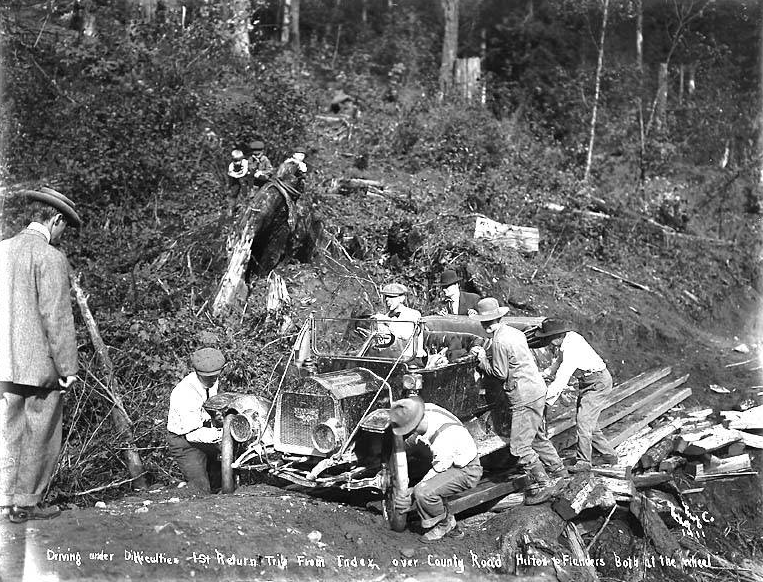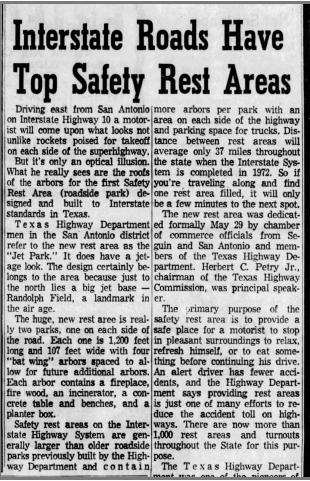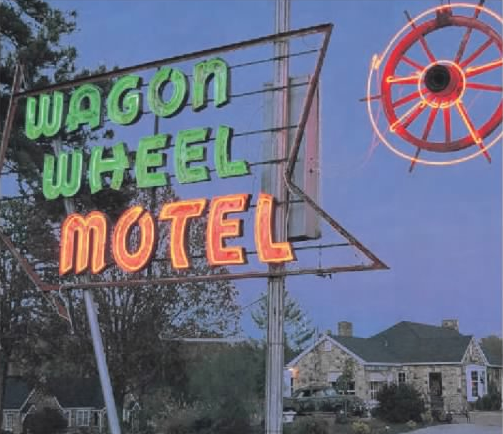On June 29, 1956, President Dwight D. Eisenhower signed the Federal-Aid Highway Act, also known as the National Interstate Defense Highways Act, creating a 41,000-mile system of interstate highways that would forever change travel in the country! The highways would make travel more efficient and create key routes to evacuate urban centers in the event of an atomic attack.

An interstate highway system was a far cry from the rutted dirt roads that existed when Henry Ford introduced the Model T in 1908. Wet weather presented a challenge for drivers, turning dirt roads into muddy quagmires. As the number of households that owned a car increased, so did the need for safe roads. Building roads was expensive and the costs were often covered by private companies that invested in the infrastructure in order to reap long term rewards.
While serving in the military, Eisenhower noted Germany’s smooth and efficient autobahn. Even though an interstate highway system had been discussed for years, it became one of Eisenhower’s top priorities after he was elected President. The highway system would allow citizens to travel quickly and efficiently in the event of a nuclear strike. It could also provide a network of highways to transport military troops and goods efficiently if needed. The federal government would pick up 90% of the tab and states would be responsible for 10%. The project would be financed with revenue from a federal gasoline tax. A statute prohibited commercial facilities along the new highways, so officials planned “safety rest areas,” or rest stops. Rest stops would provide motorists with clean bathrooms, water, and picnic areas and would be placed about every half hour along the highway. They were designed to offer a respite for weary travelers and sometimes offered a colorful glimpse into the history and traditions of the area.
As the interstate highways opened, some communities experienced a negative impact when cars bypassed their towns in favor of modern four-lane highways. Roads like the Lincoln Highway and Route 66, popular when driving was still an adventure, fell out of favor. Families opted for speed along the interstate rather than meandering along the old roads where colorful signs and local businesses services competed for travel dollars. In some cases, the interstate cut through the middle of towns and displaced citizens. However, the time-saving ease and convenience of travel using the interstate highway system propelled the project forward. By 1970, a person driving from New York to Los Angeles could complete the 2,830-mile drive 17 hours faster than in 1956.
To honor his memory, in 1990 a law passed changing the official name of the interstate freeway system to “The Dwight D. Eisenhower System of Interstate and Defense Highways.”
If you would like to learn more about the history of the interstate highway system including the 1956 Federal-Aid Highway Act and subsequent acts over the years, search Newspapers.com today!




Overall good, making country mobile. But now we’re lagging behind world with faster, more efficient bullet train for long distance travel. Automakers have vested interest in keeping us in our cars.
Agreed. As well as petrochemical companies (fuel & oil), banks (financing), and auto insurance companies. Cities can always count on DOT projects for local road repair/construction work. There is definitely a layered capitalist dependency on individual automobile ownership.
Politics all ur spouting
“Capitalist” u sound like a socialist if it were for capitalism we would be less fortunate than now! U must want everything free as a true socialist but let’s hope ur not that mindset or u would still be riding a mule!
My parents were not happy about Interstate 91 coming and cutting off their land, which ran down to the Connecticut River in Vermont. They and some others hired a lawyer and fought the US Government. But of course the Gov’t won. As your article says, the interstate system forever changed travel. But it wasn’t always for the better.
We cannot even build 5 miles of wall to keep us in the USA
…and your point is…?
DEMOCRAP!
The southern border wall is not for keeping anyone IN the USA.
Ur right not to keep us in why in the heck do u, person bout comment on 5 miles of wall, bring stupid politics into this discussion? Pitiful!
You missed the part of Eisenhower’s career when he led the first motorized military convy across the US in 1919. It took about 150 days. Some of that was unreliable vehicles, but a lot was also lousy roads. He was already sensitized to the issue before he saw the autobahns and primed to appreciate the possibilities. Note that the original title included the term “National Defense”.
Sorry, it took the convoy about 50 travel days plus six rest days.
Also, Eisenhower was an observer for the Tank Corps, not the acutual convoy commander was a Lt Col McClure.
Today, some states are closing many full rest areas and converting them to parking only. Yes, this is still a safety stop, but a family with children needs the facilities.
My family drove from Missouri to Washington state in 1938. My dad’s diary of the trip indicates that there was a lot of unpaved “highways” in the west back then. I don’t remember that trip, but I do remember the reverse trip, Washington to Missouri in 1941. I think all the highways we traveled were paved by then. I’d like to read a report on the progress of paving over the dirt roads and highways.
There was a prior good highways campaign in the 1930’s. The goal was to connect every county seat in America with the county seats in all the surrounding counties, including those in adjacent states. Here in Colorado, that resulted in some hairy mountain roads, some of which are now national and interstate highways. There is a marker where old US 6 and 50 crossed into Utah. That road is now just a county road while I-70 passes a mile south.
The irony is that my family was on a road trip from Milwaukee to LA up the coast to San Francisco and then over to Yellowstone Park an back home the last half of June ’56 and through the Fourth of July holiday. When we were in LA, we marveled at the expressway roads they had at the time.
Thank you President Eisenhower. I am thankful that I can travel on today’s interstate highways as a semi driver. I’ve driven on the autobahn in Germany and was unimpressed by the lack of rest areas. No one likes to see people seeing in public. As far as high speed trains go, it is a waste of money. The money spent would be better spent on roads and bridges. Trains are a thing of the past. They make you dependant on rental vehicles or taxis. I like the independence of going and stopping where I want to. If you want speed, fly!
Speed what’s the hurry like Ronald said fly! U in that big of hurry not me enjoy seeing America . I like to fly but can’t see didly, I rode a train as a kid but is a controlled ride but driving go, stop , stay & enjoy the sites & the sights! We only have so much time here on earth!